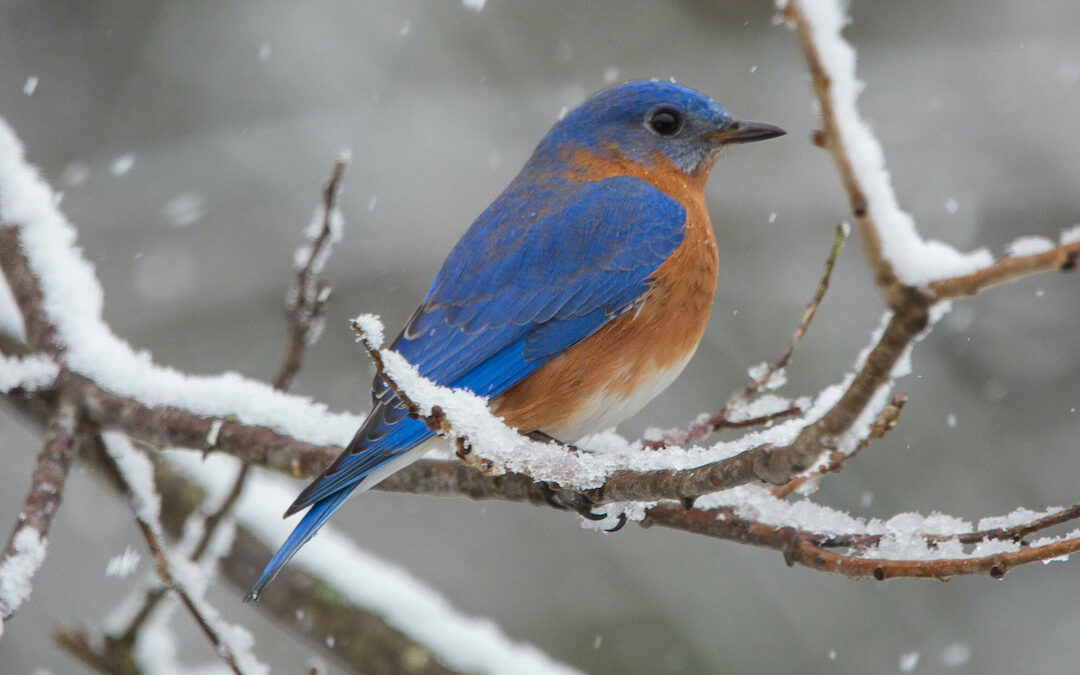As bluebirds feasted on the juicy berries outside my kitchen window, they soothed my sadness in an isolating time of collective grief — and changed my view.
A flash of vibrant, striking blue stole my breath. Instant delight. A lucky spark. Magic, so close I could almost touch it.
Enchantment informed me of the bird’s name before my brain absorbed the shape and color of its body. I’d felt it once before, on a spring morning with my friend Elizabeth in her garden. We’d both seen the brilliant, flashy blue fly over our heads to a tree limb.
“Bluebird!” she said. “It’s going to be a GOOD day!”
On this February Saturday, 2021, the bluebird perched on a winterberry shrub loaded with bright red berries outside our kitchen window. It plucked a plump berry, then another. To get a better view and picture, I approached the window, but it sensed me and flew away.
Failing to See
Bird-watching is one of those supposedly fun things I feel like I should be into as a nature-lover, gardener and conservation writer. But it had never hooked me.
Seeing and learning about birds enthralls me. Looking for specific birds high up in the trees or sky frustrates me.
I’ve tried. My mom and I spent one October week on a hawk-watching trip to Cape May, N.J. When the expert hawk watcher stood with us on the platform and described what she saw through her binoculars, I rarely saw the same thing through mine and grew weary.
My neck hurt, so I went for a walk on the beach.
Perhaps it’s my vision, extremely near-sighted and corrected with powerful lenses since I was four. Or maybe I wasn’t even looking at the right patch of sky, or just not patient enough.
Because when I can actually see birds, they captivate me first with their color, then with their behavior, design and extraordinary innate abilities. The Ruby-Throated hummingbird, a beating blur of shimmering emerald and gold, is barely as big as my thumb and yet flies 18-22 hours non-stop, 500 miles, to cross the Gulf of Mexico during its migration.
Incredible. It’s not magic, but learning about it or — even better — seeing the tiny creature in action feels magical to me.
The hawk-watching trip was still fun. I spotted a fierce merlin — a falcon-like hunter — swoop in over a marsh for the kill, and always have a good time traveling with my mom. We explored the trails and the seaside town with its boardwalk and colorful Victorian buildings.
And — I discovered watching the bird-watchers is easier and far more entertaining than squinting and fussing with binoculars. People absorbed in their passion fascinate me.
Hunger Meets Longing
Then — this spectacular little bird appeared in near-perfect view, nearly a year into the pandemic when I longed to see my mom, and Elizabeth and lots of friends. No binoculars necessary.
Sunday morning’s light offered an even better look at the round bird’s cheerful blue feathers and rust-colored throat and belly. I’d planted these little winterberry shrubs, a wedding gift, seven years ago, hoping they would someday grow tall enough to see from the kitchen and brighten even the gloomiest winter day. And since they are native to this ecosystem, their blossoms provide nectar for pollinating insects and their berries are food for the birds. (For more on winterberry, holly and native plant.)
But I’d never witnessed a bird eating the berries — until then.
Wary of scaring him away, I started from across the kitchen, tiptoeing ever closer, snapped a few pictures and watched.
He chomped one bright red berry after another. When my husband walked into the kitchen, the bluebird flew away (and I shushed my husband for entering his own kitchen).
But I had a picture to send to my mom, who confirmed I was indeed looking at a bluebird, a male. She tends bluebird boxes on a trail along a public golf course.
A little while later, there was another bird of the same round shape, mostly grey with just a bit of the bright blue streaking the wings. A female. (If you’re curious about how to identify bluebirds.)
A pair? How sweet!
The Holy Kitchen Sink
By then, still in my pajamas, I realized I wouldn’t make it to church, which is next door. So, I turned on the radio to listen to the service, broadcast into the parking lot during the pandemic.
Cheating, I know. But I could listen, wash the dishes — and stay glued to the window, watching the bluebirds.
The bluebirds stayed just outside the window, feasting on berries. Then came another. THREE! And another — FOUR bluebirds! They would fly back and forth to the low branches of the giant sycamore-like Oriental plane tree in front of our neighbor’s house.
The bluebirds got comfortable, plucking away. They stayed among the juicy berries, despite my washing, rinsing and stacking, and the sounds of hymns and prayers through the speaker.
They fed their hunger — and in turn, along with the music and prayers, comforted me through my sadness as a guest pastor from the local nursing home spoke of losing so many patients to COVID and how even before the pandemic some people had no one to visit them.
A Conservation Success Story
That week, the bluebirds and I fed each other.
When the cold has set in and turned everything to ice, the bluebirds along with lots of birds, need water. Makes sense. So I boiled water in the kettle then carried it outside to a bowl set into the deep snow, and added some snow in case the water was too hot. On one of these little trips, I looked up to see five bluebirds watching from their perch on a low branch of our neighbor’s maple tree.
My effort with the water was teensy compared to the thousands of conservation-minded folk who stepped up a century ago to reverse the habitat losses that had led to the steep decline of Eastern Bluebird populations. The many factors include when people brought invasive, aggressive and non-native house sparrows and European starlings to the United States. These species took over the nesting spots and habitat critical to bluebirds, according to the American Bird Conservancy primer on Eastern Bluebirds.
People installed bluebird nest boxes and nest box trails. In areas where the rest of the habitat is healthy for bluebirds — open pasture with little human traffic and pesticide use — bluebird populations increased. (Read more about this.)
Outside my window, the bluebirds feasted on the juicy berries, providing an up-close view of the beautiful, inter-connectedness of all things, soothing my sadness in an isolating time of prolonged, collective grief. Their images became a gift I could share with people I had not seen in far too long, and a way to make a new friend with a local naturalist, artist and wildlife photographer.
A Bluebird Buffet
Mealworms are their favorite, said my new friend. So I bought a $20 bag of dried mealworms. Only the best for “my” bluebirds. On a bright Saturday with a powder blue sky and sparkling snow, I assembled the bluebird feeding station with water and a plate of mealworms.
That Sunday morning, a whole glorious flock of bluebirds settled into the winterberry.
Then, so did a few chickadees and a flock of dark grey, bigger birds. I blamed juncos, but now suspect they were starlings, known to quickly strip branches of their berries. The bluebirds held their own and kept nibbling. But they couldn’t keep pace with the greedy gobblers.
I gasped.
Over the next hour, my husband popped in and out of the kitchen to monitor the feeding frenzy — and marvel that my effort had drawn too many birds.
In the time it took me to shower and get ready for church, we were down to just a few berries. When we returned home, every single berry was gone.
There went the ruby red that helps me through winter. And off went the bluebirds — despite the plate of untouched mealworms.
My husband sat at the kitchen table, chuckling and shaking his head, entertained by watching a newly hooked bird-watcher.


I am always on the lookout for cardinals. Every once in a while, I will spot one and automatically say Hello Herbie! Spotting a cardinal means a loved one is near and I miss my husband so much. I will now also look for a bluebird!
I am always on the lookout for cardinals. Every once in a while, I will spot one and automatically say Hello Herbie! Spotting a cardinal means a loved one is near and I miss my husband so much. I will now also look for a bluebird! Keep up the good work Lisa!
Thank you Bev! Yesss! Cardinals are a wonderful sight — and evoke that connection to a lost loved one. Thanks so much for being here and your encouragement. Take good care.